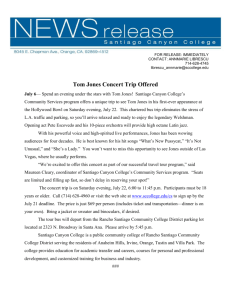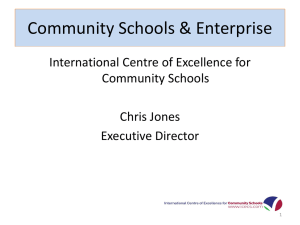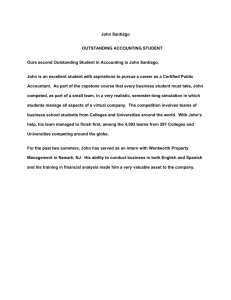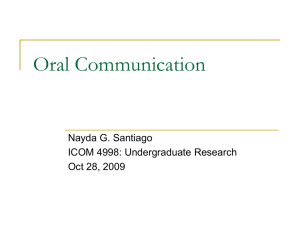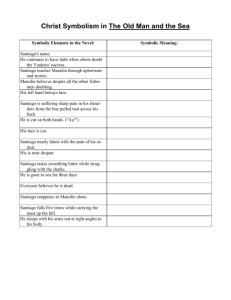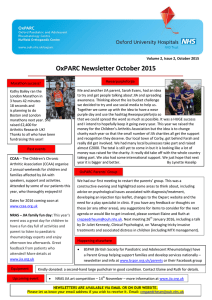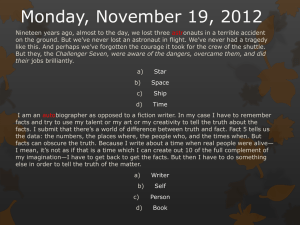شرائح المحاضرات لمشروع 1
advertisement
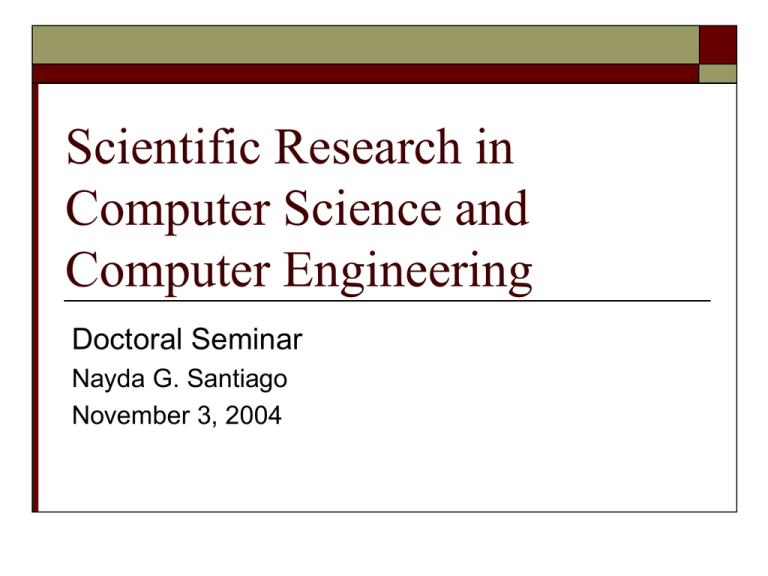
Scientific Research in Computer Science and Computer Engineering Doctoral Seminar Nayda G. Santiago November 3, 2004 Outline Introduction What is science What is scientific research Research methodologies PhD? PhD Definition Philosophiae Doctor (Doctor of Philosophy) “degree granted by a university to a learned individual who had achieved the approval of his peers and who had demonstrated a long and productive career in the field of philosophy” “degree to be granted to someone who had undertaken original research in the sciences or humanities ” Philosophy? Definitions Love and pursuit of wisdom by intellectual means and moral selfdiscipline Investigation of the nature, causes, or principles of reality, knowledge, or values, based on logical reasoning rather than empirical methods. The critical analysis of fundamental assumptions of beliefs. A set of ideas or beliefs relating to a particular field or activity; an underlying theory. General laws or principles under which all the subordinate phenomena or facts relating to that subject are comprehended. What Research is not Research isn’t information gathering: Gathering information from resources such books or magazines isn’t research. No contribution to new knowledge. Research isn’t the transportation of facts: Merely transporting facts from one resource to another doesn’t constitute research. No contribution to new knowledge although this might make existing knowledge more accessible. What Research Is “…the systematic process of collecting and analyzing information (data) in order to increase our understanding of the phenomenon about which we are concerned or interested.”1 1. Leedy P. D. and Ormrod J. E., Practical Research: Planning and Design, 7th Edition. 2001. Research Characteristics 1. 2. 3. 4. 5. 6. 7. Originates with a question or problem. Requires clear articulation of a goal. Follows a specific plan or procedure. Often divides main problem into subproblems. Guided by specific problem, question, or hypothesis. Accepts certain critical assumptions. Requires collection and interpretation of data. Scientific Method Hypothesis Sequence of experiments Randomization Repetition Change one parameter/experiment Prove/Disprove Hypothesis Document for others to reproduce results Taken from “How to have a bad carreer in research/academia” by David Patterson, Feb 2002. Scientific Method From phyun5.ucr.edu/~wudka/Physics7 “Computer” Scientific Method Hunch 1 experiment and change all parameters Discard if doesn’t support hunch Why waste time? We know this! Taken from “How to have a bad carreer in research/academia” by David Patterson, Feb 2002. Research Projects Research begins with a problem. This problem need not be Earth-shaking. Identifying this problem can actually be the hardest part of research. In general, good research projects should: Address an important question. original and significant Advance knowledge. Taken from: Research Concepts by Chris Jones and Xiaoping Jia (minor modifications by Nayda Santiago) Incorrect Choice - Research Projects The following kinds of projects usually don’t make for good research: Comparing data sets. Correlating data sets. Problems with yes / no answers. Taken from: Research Concepts by Chris Jones and Xiaoping Jia (minor modifications by Nayda Santiago) High-Quality Research Good research requires: The scope and limitations of the work to be clearly defined. The process to be clearly explained so that it can be reproduced and verified by other researchers. A thoroughly planned design that is as objective as possible. Taken from: Research Concepts by Chris Jones and Xiaoping Jia (minor modifications by Nayda Santiago) High Quality Research (cont.) Exercise Graphic Organizer A graphic organizer is a visual representation of concepts, knowledge, or information that can incorporate both text and pictures. Examples include calendars, maps, Venn diagrams, and flow charts. Graphic organizers allow the mind 'to see' undiscovered patterns and relationships. Do a map of your research (5 minutes) Establish relationships Use arrows High-Quality Research (cont.) Good research requires: Highly ethical standards be applied. All limitations be documented. Data be adequately analyzed and explained. All findings be presented unambiguously and all conclusions be justified by sufficient evidence. Vocabulary - definition Taken from: Research Concepts by Chris Jones and Xiaoping Jia (minor modifications by Nayda Santiago) Sources of Research Problems Observation. Literature reviews. Professional conferences. Experts. Previous experience Taken from: Research Concepts by Chris Jones and Xiaoping Jia (minor modifications by Nayda Santiago) Sources of Research Problems Observation. Literature reviews. Professional conferences. Experts. Taken from: Research Concepts by Chris Jones and Xiaoping Jia (minor modifications by Nayda Santiago) Stating the Research Problem Once you’ve identified a research problem: State that problem clearly and completely. Determine the feasibility of the research. Identify subproblems: Completely researchable units. Small in number. Add up to the total problem. Must be clearly tied to the interpretation of the data. Taken from: Research Concepts by Chris Jones and Xiaoping Jia (minor modifications by Nayda Santiago) Hypotheses Hypotheses are tentative, intelligent guesses as to the solution of the problem. There is often a 1-1 correspondence between a subproblem and a hypothesis. Hypotheses can direct later research activities since they can help determine the nature of the research and methods applied. Taken from: Research Concepts by Chris Jones and Xiaoping Jia (minor modifications by Nayda Santiago) Delimitations All research has limitations and thus certain work that will not be performed. The work that will not be undertaken is described as the delimitations of the research. Scope Taken from: Research Concepts by Chris Jones and Xiaoping Jia (minor modifications by Nayda Santiago) Definitions Define each technical term as it is used in relation to your research project. This helps remove significant ambiguity from the research itself by ensuring that reviewers, while they may not agree with your definitions, at least know what you’re talking about. Taken from: Research Concepts by Chris Jones and Xiaoping Jia (minor modifications by Nayda Santiago) Assumptions Assumptions are those things that the researcher is taking for granted. For example: a given test instrument accurately and consistently measures the phenomenon in question. As a general rule you’re better off documenting an assumption than ignoring it. Overlooked assumptions provide a prime source of debate about a research project’s results. Taken from: Research Concepts by Chris Jones and Xiaoping Jia (minor modifications by Nayda Santiago) Importance of the Study Many research problems have a kind of theoretical feel about them. Such projects often need to be justified: What is the research project’s practical value? Without this justification, it will prove difficult to convince others that the problem in question is worth study. Taken from: Research Concepts by Chris Jones and Xiaoping Jia (minor modifications by Nayda Santiago) Research Proposals Research proposals are documents that describe the intended research including: Problem and subproblems. Hypotheses. Delimitations. Definitions. Assumptions. Importance. Literature review. Taken from: Research Concepts by Chris Jones and Xiaoping Jia (minor modifications by Nayda Santiago) Literature Review A literature review is a necessity. Without this step, you won’t know if your problem has been solved or what related research is already underway. When performing the review: Start searching professional journals. Begin with the most recent articles you can find. Keep track of relevant articles in a bibliography. Don’t be discouraged if work on the topic is already underway. Taken from: Research Concepts by Chris Jones and Xiaoping Jia (minor modifications by Nayda Santiago) Literature Review Pitfalls Be very careful to check your sources when doing your literature review. Many trade magazines are not peer reviewed. Professional conferences and journals often have each article reviewed by multiple people before it is even recommended for publication. The IEEE and ACM digital libraries are good places to start looking for legitimate research. Taken from: Research Concepts by Chris Jones and Xiaoping Jia (minor modifications by Nayda Santiago) Literature Review Pitfalls (cont.) The Internet can be a good source of information. It is also full of pseudo-science and poor research. Make sure you verify the claims of any documentation that has not been peer reviewed by other professionals in the computing industry. Taken from: Research Concepts by Chris Jones and Xiaoping Jia (minor modifications by Nayda Santiago) Processes & Methodologies Research Process. Common Methodologies. Methodology Comparison. Taken from: Research Concepts by Chris Jones and Xiaoping Jia (minor modifications by Nayda Santiago) Research Process Research is an extremely cyclic process. Later stages might necessitate a review of earlier work. This isn’t a weakness of the process but is part of the built-in error correction machinery. Because of the cyclic nature of research, it can be difficult to determine where to start and when to stop. Taken from: Research Concepts by Chris Jones and Xiaoping Jia (minor modifications by Nayda Santiago) Step 1: A Question Is Raised A question occurs to or is posed to the researcher for which that researcher has no answer. This doesn’t mean that someone else doesn’t already have an answer. The question needs to be converted to an appropriate problem statement like that documented in a research proposal. Taken from: Research Concepts by Chris Jones and Xiaoping Jia (minor modifications by Nayda Santiago) Step 2: Suggest Hypotheses The researcher generates intermediate hypotheses to describe a solution to the problem. This is at best a temporary solution since there is as yet no evidence to support either the acceptance or rejection of these hypotheses. Taken from: Research Concepts by Chris Jones and Xiaoping Jia (minor modifications by Nayda Santiago) Step 3: Literature Review The available literature is reviewed to determine if there is already a solution to the problem. Existing solutions do not always explain new observations. The existing solution might require some revision or even be discarded. Taken from: Research Concepts by Chris Jones and Xiaoping Jia (minor modifications by Nayda Santiago) Step 4: Literature Evaluation It’s possible that the literature review has yielded a solution to the proposed problem. This means that you haven’t really done research. On the other hand, if the literature review turns up nothing, then additional research activities are justified. Taken from: Research Concepts by Chris Jones and Xiaoping Jia (minor modifications by Nayda Santiago) Step 5: Acquire Data The researcher now begins to gather data relating to the research problem. The means of data acquisition will often change based on the type of the research problem. This might entail only data gathering, but it could also require the creation of new measurement instruments. Taken from: Research Concepts by Chris Jones and Xiaoping Jia (minor modifications by Nayda Santiago) Step 6: Data Analysis The data that were gathered in the previous step are analyzed as a first step in ascertaining their meaning. As before, the analysis of the data does not constitute research. This is basic number crunching. Taken from: Research Concepts by Chris Jones and Xiaoping Jia (minor modifications by Nayda Santiago) Step 7: Data Interpretation The researcher interprets the newly analyzed data and suggests a conclusion. This can be difficult. Keep in mind that data analysis that suggests a correlation between two variables can’t automatically be interpreted as suggesting causality between those variables. Taken from: Research Concepts by Chris Jones and Xiaoping Jia (minor modifications by Nayda Santiago) Step 8: Hypothesis Support The data will either support the hypotheses or they won’t. This may lead the researcher to cycle back to an earlier step in the process and begin again with a new hypothesis. This is one of the self-correcting mechanisms associated with the scientific method. Taken from: Research Concepts by Chris Jones and Xiaoping Jia (minor modifications by Nayda Santiago) Common Methodologies Methodologies are high-level approaches to conducting research. The individual steps within the methodology might vary based on the research being performed. Two commonly used research methodologies: Quantitative. Qualitative. Taken from: Research Concepts by Chris Jones and Xiaoping Jia (minor modifications by Nayda Santiago) Methodology Comparison Quantitative Explanation, prediction Test theories Known variables Large sample Standardized instruments Deductive Qualitative Explanation, description Build theories Unknown variables Small sample Observations, interviews Inductive Taken from: Research Concepts by Chris Jones and Xiaoping Jia (minor modifications by Nayda Santiago) References 1. Leedy P. D. and Ormrod J. E., Practical Research: Planning and Design, 7th Edition. 2001. Questions? ?????????
